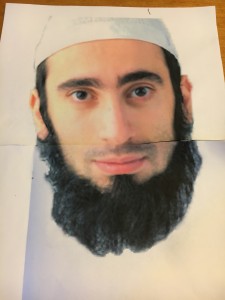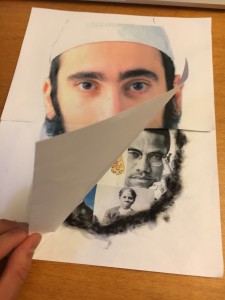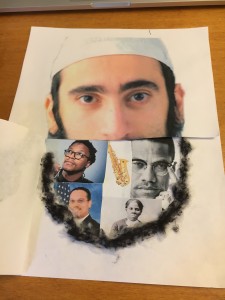


One particularly memorable scene in The Reluctant Fundamentalist occurs when Wainwright, one of Changez’s co-workers at Underwood Samson, suggests that his new beard is not making him “Mister Popular around the office” given the terrorist attacks of September 11th. Changez then replies that the beard is simply part of his culture, to which Wainwright replies “Jerk chicken is common where I come from…but I don’t smear it all over my face”. While this exchange certainly provides a bit of comedic relief in contrast to Changez’s serious personal struggles, the prejudice that Wainright conveys on behalf of their other coworkers is unfortunately all too real in today’s society. Much like the veil, the thick beard of a Muslim man, in keeping with model of the Prophet Muhammad who was also believed to have kept a beard, is perhaps one of the most prominent “symbols” of the monolithic “Islam” that breeds a culture of fear surrounding the faith in the US.
Of course, as discussed in Prof. Asani’s final lecture, this stereotypical image of a Muslim is but one of many faces of Islam in the United States. I was particularly taken by his description of how a large portion of the Muslim population is in fact African American, with many tracing their lineage to Muslim Africans brought to the Americas through the slave trade. This population then went on to have incredible influence on shaping modern culture and society in the United States. These contributions are clearly outlined in Aidi’s piece, Rebel Music, which describes not only Islam’s influence on jazz and the United States’ international relations (through “Jazz ambassadors” to both Soviet states, and more recently, to the Middle East), serving as a symbol of American democracy, but also in providing many African Americans a greater sense of identity and community during times of great discrimination and oppression.
In order to demonstrate the need to look beyond this stereotypical image of a Muslim and gain a more complete understanding of this tradition’s integral role in US history and culture, I took the first image that came up on a Google search for “Muslim man”, which was of course a man sporting the beard and the traditional clothing of an imam, and essentially gave him a “moveable” beard, which can be flipped to reveal a collage of a few prominent African American Muslims, including Malcom X and Keith Ellison, the first Muslim American elected to Congress. I also included Harriet Tubman, being one of the most widely recognized abolitionists, and a former slave herself, in order to represent how, as Aidi puts it, “Islam in the West and empire and racial exclusion are entwined.” In creating this piece, I hoped to not so much remove the beard as a means of diminishing the man’s identity as a Muslim, but rather to give the viewer the opportunity to actively look past it and see a small representation of the diversity of people that truly make up Muslims in the United States.

0 responses so far ↓
There are no comments yet...Kick things off by filling out the form below.
Leave a Comment